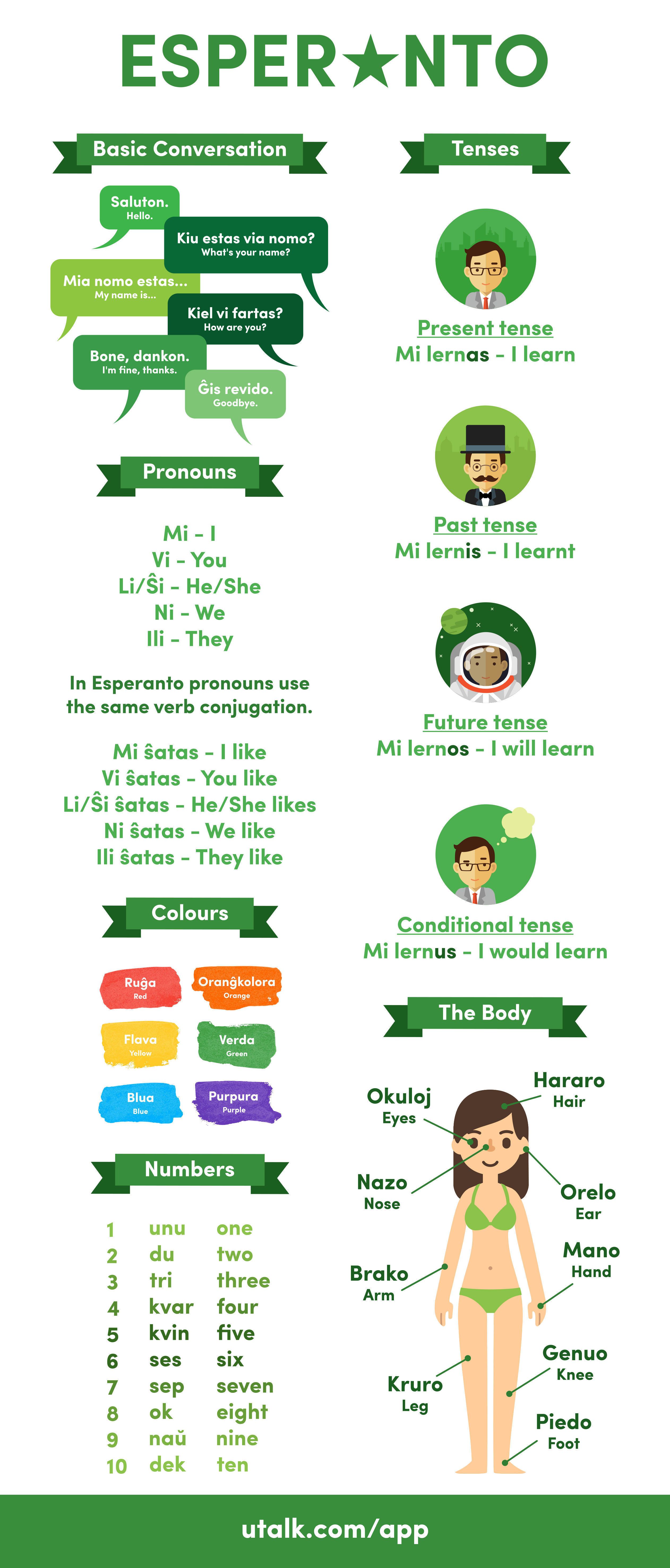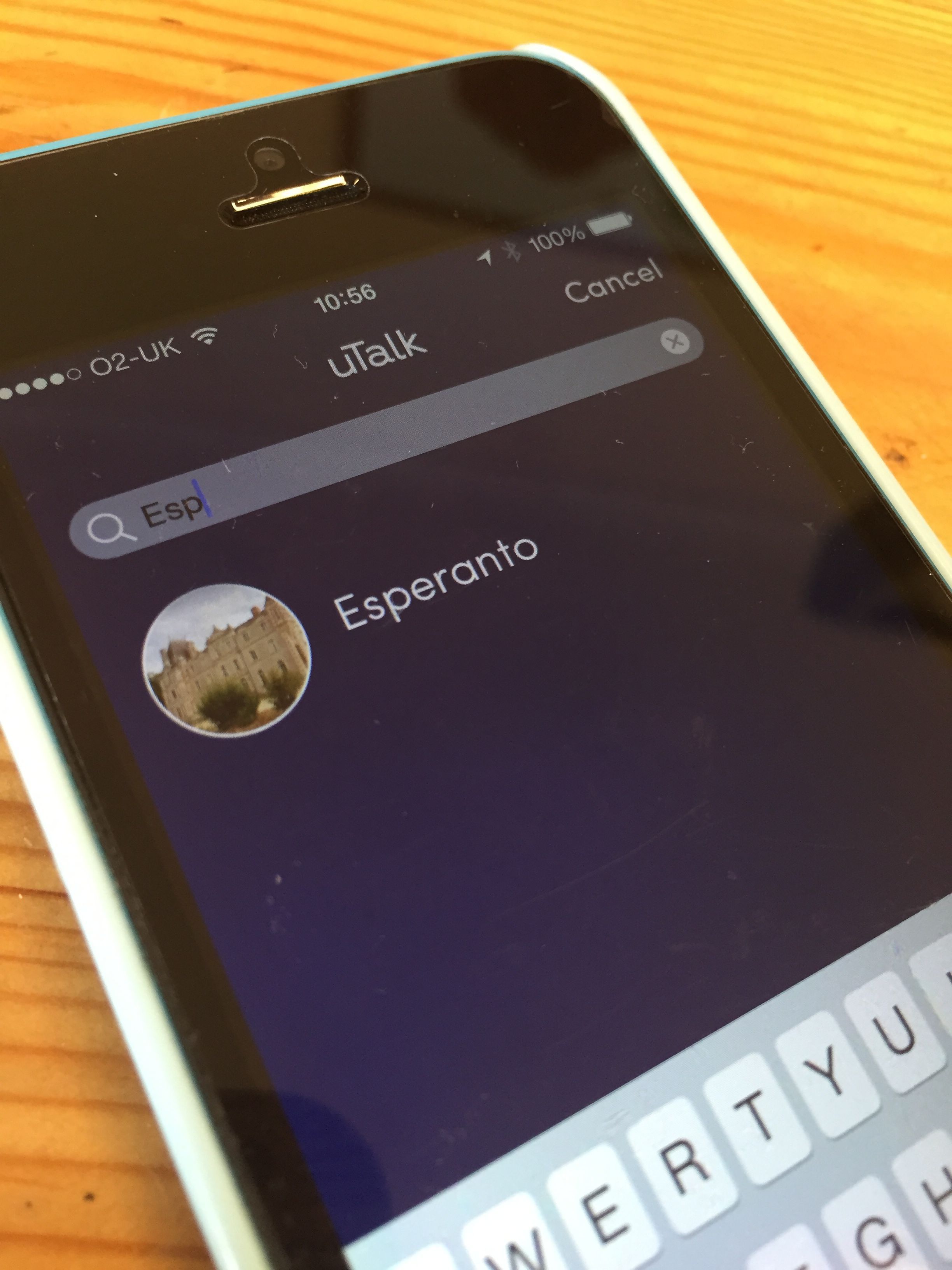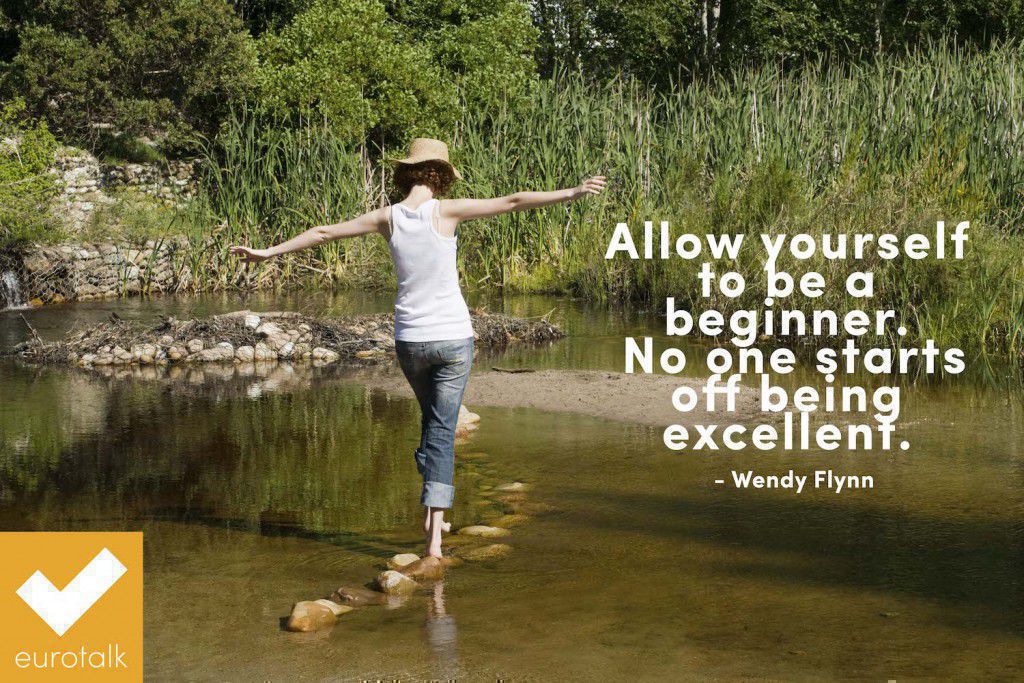A beginner’s guide to Esperanto
We hope you’ve enjoyed our Esperanto week! If we’ve convinced you to give the language a try, you might find this handy beginner’s guide a good place to start… Please feel free to share it with anyone you think might be interested.
And for more information about Esperanto, visit edukado.net, a site run by linguist Katalin Kováts, who worked with us on the translation and recording of uTalk Esperanto.
Following a request, this guide is now also available in Spanish.
Embed This Image On Your Site (copy code below):
Why learn Esperanto?
Saluton! Mia nomo estas Nat, kaj mi lernas Esperanton.
Whilst others jet-set away to sunny beaches and tropical climes this summer, my plans are slightly more academic. I will be learning Esperanto. OK, I’ll take a break too, but I’m really excited about my summer goal, and I’m hoping to achieve it within two months.
What, Why, How?
All good questions. Let’s start with ‘What’.
What is Esperanto?
Esperanto is a language invented by Ludwig Zamenhof, whose idea was to create an international, apolitical language which is very, very (very) easy to learn. Since its creation in the 1880s, it’s seen surges and declines in popularity, and is currently spoken by up to two million speakers, and – quite amazingly – up to 2,000 native speakers. Esperantists place a heavy emphasis on how speaking and engaging with Esperanto makes people operate on an equal footing, and can open up communication opportunities all over the world.
Why learn Esperanto?
 So why learn it? Unlike with other languages, you don’t have the goal of going to the target country to finally try out some of your new Esperanto phrases. There is no Esperanto country, of course. But Esperantists tend to be incredibly friendly and welcoming to those who learn the language, making it easy to find conversation partners or groups, especially in the age of the internet. Esperantists even have their own ‘Passport Service’, by which travelling Esperantists can find locals who are willing to open their houses up to fellow speakers, making it easy to travel abroad and widen your Esperantist community.
So why learn it? Unlike with other languages, you don’t have the goal of going to the target country to finally try out some of your new Esperanto phrases. There is no Esperanto country, of course. But Esperantists tend to be incredibly friendly and welcoming to those who learn the language, making it easy to find conversation partners or groups, especially in the age of the internet. Esperantists even have their own ‘Passport Service’, by which travelling Esperantists can find locals who are willing to open their houses up to fellow speakers, making it easy to travel abroad and widen your Esperantist community.
Personally, I’m mostly in it out of fascination. I’ve heard how easy it is to learn and I want to see for myself how much I can achieve in two months. During our uTalk Esperanto recording, I picked up a couple of the basics and they’ve stuck with me, which has encouraged me to think that I might be able to pick up a lot more fairly quickly.
I’m also interested in the application of Esperanto, beyond just learning it for personal enjoyment. Because the language is so simple (just 16 grammar rules!) and completely regular (yes, completely!), it can be effectively used as a bridge language between communities who otherwise might struggle to communicate. It’s also been trialled extensively in primary schools, where the logic goes that teaching Esperanto enables children to get to a very high language standard very quickly, so that they can start being creative in a foreign language early on. They can then transfer the skills over to other languages they study later: effectively, they have not just learnt Esperanto, but learnt how to learn a language. And done it without the chronic frustration of trying to remember how the irregular past participle should be formed, which taints most people’s memories of school-day French and makes them feel, even as adults, that they ‘cannot’ learn a language. Instead, children can chatter away with relative fluency, experiencing the liberation of communicating in another tongue at a really young age. To learn more, watch this video:
I also like the sound of it. To me, Esperanto has a slightly Eastern European tinge, with a mish-mash of vocabulary which I can sometimes recognise from other languages. Already, as an English speaker, I am familiar with the following basic words:
Jes (Yes)
trajno (train)
Mi lernas (I learn)
boato (boat)
fiŝo (fish)
And from other languages, I recognise:
Dankon (Thanks)
fermita (closed)
ombro (shade)
glacio (ice)
Where am I starting from?
I’m a total beginner: I haven’t ever picked up an Esperanto book, and I don’t own one. However, from my interaction with our Esperanto voiceover artists and translators, I have picked up a few things which in other languages would take me weeks of effort. So I feel like I’m starting from an advantage. What I know is this:
Adjectives
Always end in an -a. To form the opposite of the adjective, you just add ‘mal-‘ in front of it. So:
Granda – big
Malgranda – small
Fermita – closed
Malfermita – open
Vera – true
Malvera – false
Nouns
Always end in -o. Always! To form the feminine, you just add ‘-in-‘ before the final ‘o‘:
turisto – turistino
aktoro – aktorino
kantisto – kantistino
Verbs
‘mi‘ is ‘I’, ‘ŝi‘ is ‘she’, ‘li‘ is he’, ‘vi‘ is ‘you’, and present tense verbs always end in ‘-as‘. So:
Mi lernas – I learn
Li lernas – he learns
Vi lernas – you learn.
How will I learn?
By any means possible. Not coincidentally, uTalk Esperanto has just been released, and that’s going to help me hugely with pronunciation and vocabulary. I’ve also got Katalin Kováts’ Poŝamiko (‘Pocket friend’), a book to guide me on the basics, and then all of the resources listed at http://en.lernu.net/ – more than enough to keep me going for the next few months. After that, who knows – perhaps some conversation classes?
Wish me luck!
Nat
If you’d like to join Nat in learning Esperanto, download uTalk from the App Store to get started!
Quote of the week: 11 Jul 2015
“Allow yourself to be a beginner. No one starts off being excellent.” Wendy Flynn
Embed This Image On Your Site (copy code below):
5 great songs to help you learn English
Everyone knows the key to language learning is immersion, but upping sticks and moving to the country where your language originates from is a huge commitment and not always possible.
However. There are a few things you can do to help your learning along. Watching films (with or without subtitles, depending on how brave you are), reading an online magazine or newspaper entirely in the language you’re trying to learn, and if you’re really fearless, try changing the language on all your devices – phone, tablet, computer and so on. Just be sure you know enough words to change it back.
 My personal favourite way though, which I actually use myself when I am learning, is to listen to music. There is no quicker way to immerse yourself in a language, learn pronunciation, subject word order, vocabulary, colloquialisms, hidden meanings and double entendres, and so on. The list is technically endless and completely adaptable to whatever level you are.
My personal favourite way though, which I actually use myself when I am learning, is to listen to music. There is no quicker way to immerse yourself in a language, learn pronunciation, subject word order, vocabulary, colloquialisms, hidden meanings and double entendres, and so on. The list is technically endless and completely adaptable to whatever level you are.
Here are my five favourite English songs that I use in class with my students; what would you add to the list?
Passenger – Let Her Go
This song is perfect for learning English. The song is played just about everywhere so it’s instantly recognisable, the pace is not slow enough to make you feel daft but not so quick as to make you feel lost, and the most important thing is that Mike Rosenberg, the singer and face of Passenger, has a beautiful, clear voice that not only is nice to listen to but easy to understand.
Coldplay – The Scientist
Another really good song for learning. Clear lyrics, slow pace, understandable voice, (thanks, Chris Martin), and an interesting video to talk or think about once you know all the words. Resultant group discussions have included trains, drinking and driving, graffiti, and the environment. Watch the video if you’re not sure why.
Snow Patrol – Chasing Cars
What is good about this one is not so much the pace of the song but the simplicity of the lyrics. The verses are really short, and Gary Lightbody’s pronunciation on this one is a gentle exposure to the Irish accent in song. If you choose this song as one of the first to learn with, you’ll feel a real sense of achievement quickly because it’s such a simple one to learn.
Muse – Feeling Good
Music trivia for you first: did you know that this song was first written by Anthony Newley and Leslie Bricusse for the 1965 musical The Roar of the Greasepaint and has been covered by, amongst others, Nina Simone, Sammy Davis Jr and Michael Bublé? I have chosen the Muse version because I personally love Muse, plus Matt Bellamy’s voice on this one is slightly harder than my previous suggestions. Why is this a good thing? Well, the song is very recognisable and most people have heard at least one version of it, so when you hear this version you’ll likely know some of the lyrics already and will be exposed to yet another accent – and you’ll understand it. Bonus!
Maximo Park – Acrobat
I am a mean teacher. Or I can be. So when I am presented with a student who says they can understand all English lyrics and I know otherwise, I give them this track to try. Because all the verses on this track are spoken, which sounds easy, doesn’t it? It’s not. The beautiful Paul Smith is from Teeside, so firstly we have the exposure to the accent and secondly, he doesn’t speak slowly at all. By the time you get to the first chorus you’ll probably throw your pen down in relief and look at your paper in alarm with the five words you’ve managed to scribble down. But it’s worth it. I promise.
If you’re not sure how to use music to learn a language, here’s my ‘how to’:
- Choose a song and listen to it a couple of times.
- Listen again and start writing down the lyrics that you recognise. Repeat as often as your patience allows.
- Look up the lyrics, either with something like AZLyrics or Lyric Translate, the latter of which will actually have your lyrics and the translated version side by side.
- Watch a lyric video so you can see the words whilst you hear them. Singing is optional but hey, why not?
Sound easy? Give it a go!
Kelly
Top 10 tips for learning a language
We originally published this infographic back at the start of last year as ‘top 10 tips for learning a language in 2014‘. But if there’s one thing we know, it’s that learning a language is something you can do anytime, anywhere.
So here are our top 10 tips for learning a language – whenever you want!
If anyone has any more top tips that work really well for you, please share them in the comments. Thank you 🙂


